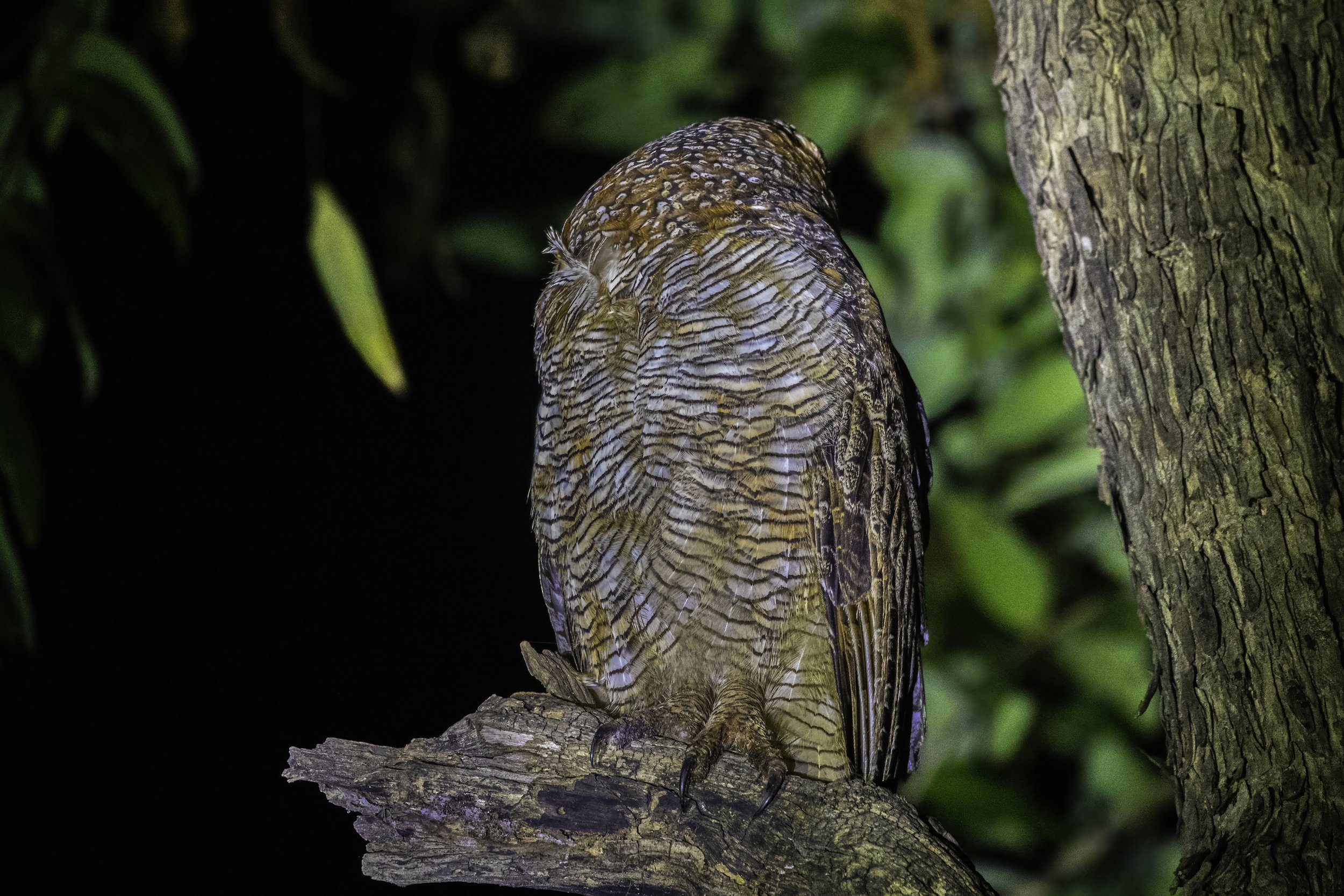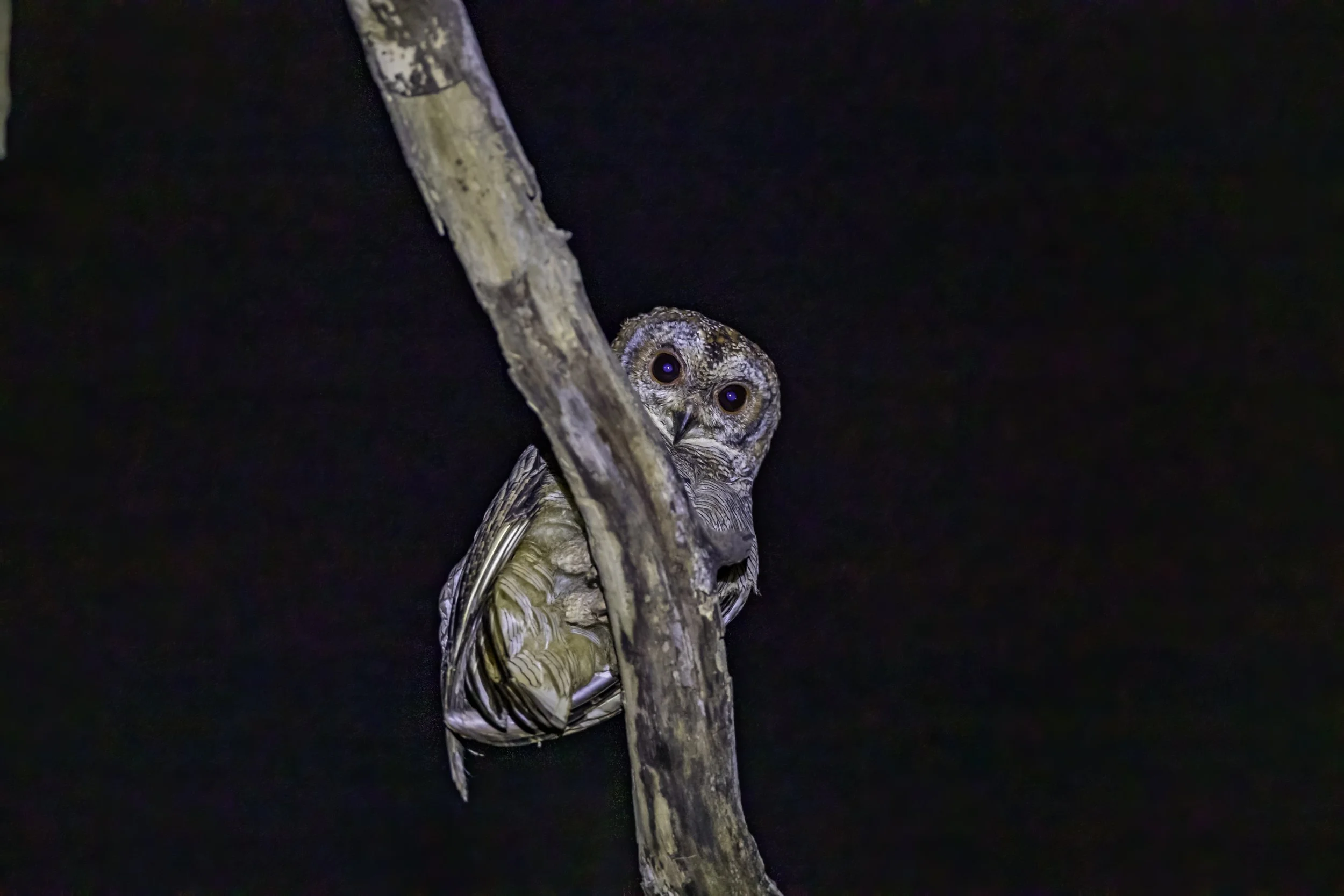Mottled Wood Owl
Strix ocellata
Tadoba Andhari Tiger Reserve - Junona Buffer Night Safari, Ananthagiri Forest Range
Owls are birds from the order Strigiformes, which includes over 200 species of mostly solitary and nocturnal birds of prey typified by an upright stance, a large, broad head, binocular vision, binaural hearing, sharp talons, and feathers adapted for silent flight. Exceptions include the diurnal northern hawk-owl and the gregarious burrowing owl. Owls hunt mostly small mammals, insects, and other birds, although a few species specialise in hunting fish. They are found in all regions of the Earth except polar ice caps and some remote islands. Owls are divided into two families: the true (or typical) owl family, Strigidae, and the barn-owl family, Tytonidae.
I’ve had some amazing opportunities to photograph a few different species of owls over the years. Like always some were easy, some were all night stands, some were in the freezing cold, some were a long walk through dense jungles, with some there was light, with some there was none AND for one of them there was a Thermal Scope!
Read about my other owls:
Blakiston’s Fish Owl - the largest living species of owls in the world, an endangered species that lives in some of the hardest-to-reach corners of northeast Asia
But today is about the Mottled Wood Owl. This was an interesting experience as it was all at night. We were on the night safari exploring the Junona Buffer zone in Tadoba in the hope of filming a tiger when we came across this beautiful specimen at three different locations. The first time we saw it was near the hamlet of Dewada and it seemed to follow us along the track as we made our way around Junona making its final appearance at the very gates to the Junona Zone.
Tadoba National Park
There are 106 existing national parks in India covering an area of 44,372.42 km², which is 1.35% of the geographical area of the country (National Wildlife Database, Dec. 2021). Among all these there is one, almost at the heart of the nation, the jewel of Vidarbh, “Tadoba National Park and Tiger Reserve”. Also known as the "Tadoba Andhari Tiger Reserve" it is the oldest and largest National Park in the state of Maharashtra and one of 47 Project Tiger reserves existing in India.
Tadoba is a jungle where, early in the day, the sun follows one like a lodestar through the tangled heads of the trees and as the day progresses it burns with a blinding exquisiteness that makes us shield our eyes and bless our existence. The light is lustrous in the open spaces and seemed undistllled from heaven to earth seeming like a laser show at times as gem clear beams filter through the trees. The warmth of it settles over our faces like a silken mask and life is a golden joy. That is the thing about the seraph-light of this jungle; it can sweep down like the handloom of the gods one moment, pure and clear and long of line.
Tadoba lies in the Chandrapur district of Maharashtra state, once ruled by the Gond Kings in the vicinity of the Chimur Hills, and is about 150 km from the closest major city, Nagpur. The total area of the tiger reserve is 1,727 km², which includes the Tadoba National Park, created in the year 1955. The Andhari Wildlife Sanctuary was formed in the year 1986 and was amalgamated with the park in 1995 to establish the present Tadoba Andhari Tiger Reserve. The word 'Tadoba' is derived from the name of God "Tadoba" or "Taru," venerated by the local adivasi (tribal) people of this region and "Andhari" is derived from the name of the river Andhari flowing in this area. Legend holds that Taru was a village chief killed in a mythological encounter with a tiger. Taru was deified and a shrine now exists beneath a large tree on the banks of the Tadoba Lake. The temple is frequented by the adivasis between the months of December through January.
The park is open to visitors from October to June every season and remains closed every Tuesday. It is divided into three separate ranges - the Tadoba north range, Kolsa south range and the Moharli range sandwiched between the two. There are two lakes - Tadoba and Kolsa - and a river which are replenished by the monsoon every year sustaining the wildlife in the park. Rich in flora and fauna the vegetation is southern tropical dry deciduous and covers about 630 km². Teak and bamboo are prominent and the northern and western parts of the reserve are hilly and dense with deep valleys and a sprinkling of lush meadows. Home to some of central India’s best native woodland bird species, about 181 including endangered and water birds, the park also boasts leopards, sloth bear, the Indian bison (Gaur), Nilgai, Dhole, Striped Hyena, small Indian Civet, numerous Jungle Cats, Chital (Axis Deer), Sambhar, Barking Deer, Four-horned antelope, Marsh Crocodiles, a profusion of Langurs and Rhesus Macaques and a good measure of reptiles like the Indian Python, Cobra and numerous other species. Tadoba, unfortunately, also has a high rate of man tiger conflict. Several instances have also been reported of wildlife killing domestic livestock and there are villages still within the forest contrary to the efforts of the Forest department so we were told. Note it is man conflicting with nature and not the other way round.
Tadoba National Park
The National Park is divided into 3 forest ranges :
Tadoba North Range
Moharli Range
Kolsa South Range
These ranges are interconnected and can be covered during a Safari from either of their gates. Each of these ranges has core zones and buffer zones. The core zone is the protected demarcated area of the forest department where the natural resources and wildlife are highly conserved and human activity is extremely limited. The buffer zone is the area surrounding or adjoining the Core Zone where conservation takes place along with some limited human activity. The core zone of Tadoba has 6 gates and the buffer zone has 12 gates of entry to the park currently. Our focus is in the Moharli zone which has its core gates – Moharli, Khutwanda and its Buffer gates – Dewada, Adegao, Agarzari, Junona & Mamla gates. Specifically this time we went into the jungle via the Junona Gate. The Junona area is a mixture of core & buffer forest area overwhelmed with thick bamboo trees making for poor visibility. There are fewer vehicles entering here and the tracks here are quite narrow with overhanging branches making for an exhilarating experience.
In Tadoba, both the core and the buffer zones have excellent sightings due to the rich and bountiful wildlife species of approximately 62 mammals, 291 birds, 9 amphibians, 34 Reptile Species, and 174 species of butterflies. The highlight for most being the 115 tigers and the 151 leopards and yes the elusive black leopard is also amongst them. While Tadoba's inner sanctum is a beautiful mixed-deciduous forest encrusted with gem-like flowering trees and the vast Telia and Tadoba lakes offer cinematic vistas, much of the core area is off limits and there are always many more visitors than available safaris. Getting a buffer pass isn't the second prize anymore, there is a new and massive network of trails, and the sightings are as good as they get and today’s focus is the exquisitely patterned Mottled Wood Owl from the Junona Buffer zone night safari.
My grateful thanks to my companions - Angad & Rishi - for bearing with me and my excesses. This would not have been possible without their help and incredible skills.
Mottled Wood Owl
The Mottled Wood Owl (Strix ocellata) is a species of large owl endemic to India. They are found in gardens and thin deciduous forests adjacent to dry thorn forests or farmland. They are easily detected by their distinctive tremulous eerie calls at dawn and dusk. The characteristic call is a duet of the male and female while other notes include a low hoot and a screech. Their large size, lack of "ear" tufts and the concentric barring on the face make them easy to identify. This large owl lacks ear tufts and is mottled and vermiculated in reddish brown and white. The face disc is marked with fine concentric black and white barring. The sexes are alike. The chin is white. The eyelid is orange and the iris is dark brown. The tail is barred narrowly in brown and black. The concentric barring on the face and mottled crown separate it from the brown wood owl in southern India.
Mottled Wood Owl - Range & Geographical Distribution
There are three subspecies recognized and there are no sharp demarcations in their distributions.
S. o. ocellata (Lesson, 1839) is found in southern India and is shorter winged in the males (333–338 mm) than grandis
S. o. grisescens Koelz, 1950 is found in northern India south of the Himalayas, west to Pakistan and east to Bihar. The markings are pale above and the males have a wing length of 338–346 mm
S. o. grandis Koelz, 1950 from Gujarat is differentiated by the wing length of the males (360–372 mm)
The mottled wood owl nominate subspecies S. o. ocellata is distributed in peninsular India. The subspecies S. o. grandis is distributed in the states of Gujarat, parts of Maharashtra and parts of Rajasthan. The subspecies S. o. grisescens is distributed in the states south of the base of Himalayas, including Punjab, Rajasthan, Haryana, Uttar Pradesh, Madhya Pradesh, Chhattisgarh, Odisha, Jharkhand and Bihar.
The species is found in the plains in gardens and lightly wooded habitats. They roost in trees during the day choosing a branch with dense foliage. These owls roost during the day, usually in pairs. When disturbed they may fly in bright sunshine although they choose to shelter within a dense grove of trees. They produce an eerie chuhua-aa call with a quaver in the second note. This call is an antiphonal duet of the male and female. The male calls one or two times followed by the female's shorter and less tremulous version. The eerie call has been associated with ill omen in some parts of Kerala. The call is interpreted as povaa-aa (="let us go" in Malayalam) and likened to a summons to the spirit world.
With that said lets move onto the gallery of this beautiful nocturnal bird which are presented in three different sets as I captured them beginning with the first sighting near the Dewada hamlet. For these photos I was using two rigs:
Canon 1Dx Mark ii paired with the Canon EF 600mm f/4L IS III &
Canon 7D Mark ii paired with the EF 100-400mm f/4.5-5.6L IS II
‡‡‡‡‡
This video was recorded completely handheld on the two rigs I have listed above in darkness. There were three of us in the gypsy and we were shifting every now and then for a better angle leading to some movement in the footage. And the constant whistling and knocking you will hear was our driver who insisted on making the sounds so we would get “good“ shots. We did ask him to desist but he continued with what I suppose most visitors on the night safari request him to do.
Related Posts




















